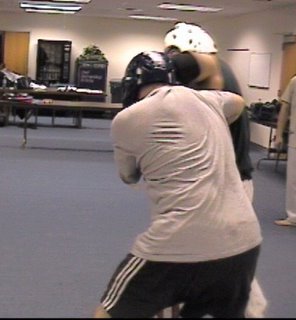Tuesday, January 31, 2006
Reminder: Karate College 2006
Update: The deadline for early registration is approaching. If you plan on attending, please let me know...
Please view my posts from last year. I highly recommend it. You will learn a lot. Hone your strengths, or improve on your weaknesses, or just learn something new. It's great for networking with other martial artists, getting ideas, and planning what you want to study next.
Thursday, June 22-Sunday, June 25 at Radford University in Blacksburg, Virginia.
Please let me know if you're interested, and we can coordinate classes, if you like. I may also be able to make recommendations on styles or instructors.
Monday, January 30, 2006
The Safety of Judo Chokes
Checking
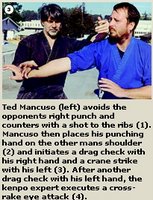 Very good Kenpo article on checking by Ted Mancuso.
Very good Kenpo article on checking by Ted Mancuso.Key points:
"...checking is the countering of a movement before it becomes an identifiable strike. In other words, a check stops an assailant before he can even start his attack."
"Don't withdraw your non-punching hand. Keep it in position to check your opponents arm as you strike back. You may sacrifice the extra power of the withdrawal, but thats a small price to pay for not being hit."
The following are four of the most effective ways kenpo teaches students to execute a checking-hands maneuver:
Active Check: It involves simply laying your checking hand over your opponents limb. For instance, he throws a right punch, and you block it while checking his left punch which he had probably planned as his next attack with your right hand. You can then simultaneously deliver a left strike to his face.
Position Check: The opponent throws a right punch, and you block it on the inside using your right hand. You simultaneously raise your left hand into a cover hand that is positioned near your right shoulder. If he attempts to throw a high left punch, your check can intercept it and allow yourself a bit of time to duck. If he attempts a low left shot to your ribs, your right (anchored) elbow is already in position to close that line of approach.
Drag or Friction Check: Dont misinterpret checks as just frozen hand motions, for they can be very lively. For instance, you toss a right hand at your opponent, and he blocks it with his left hand. Before he even thinks about it, you wipe down the length of his arm while driving forward with a left palm strike. You have used the friction check to prevent his strike and aid your counter.
Pinning Check: Your opponent grabs your lapels with both hands. Rather than
try to disengage from him, you cover and pin his arms with your left hand while you strike his solar plexus. The pinning check ensures that his limbs stay where they are, at least for a while, and it can be a perfect lead-in for a follow-up technique.
Mike and I were working on this the other day. I'd like to learn more, but this is a very effective tactic for me.
BRAZILIAN JUJUTSU PRIMER
- HALF-GUARD TO LEG LOCK
- HALF-GUARD TO KIMURA
- HALF-GUARD REVERSAL
- HALF-GUARD REVERSAL TO MOUNT
Take a look...
Hock Hochheim on "Nonsense and Punching"
 In Hock's blog entry for January 27, 2006, he dissects an article by Black Belt columnist Jim Wagner on something we've been concentrating lately - hitting with a closed fist versus an open hand.
In Hock's blog entry for January 27, 2006, he dissects an article by Black Belt columnist Jim Wagner on something we've been concentrating lately - hitting with a closed fist versus an open hand.Disclosure: I haven't been able to find Wagner's article online, and I rarely read Black Belt anymore, though I will pick it up. Also, from reading Hock's blog and articles, he isn't necessarily a fan of Wagner, though he seems to treat him fairly in his critique (as far as I know, not having read the original).
Wagner's points:
- “Men tend to close their fist under pressure.”
- “Advocates of the open hand techniques say that a person runs a higher risk of breaking his hand if he strikes an opponent with a closed fist. This is nonsense.”
- “When I hit someone with my fist, the last thing I worry about is injury. I can get it fixed later at the hospital.” (Hock-if its such nonsense, why even mention a trip to the hospital?)
Hock's rebuttal:
To suggest that humans are genetically predisposed to fighting with balled-up fists is one thing, but to say that we therefore should be stuck fighting with fists is something else. Wouldn't this “punching gene” also mean we should also de-emphasize grabbing and grappling and have natural troubles striking with eye attacks, hammer fists, forearms and elbows? Somehow, with a little very training, people do these other things.
The open palm strike or palm heel strike was placed into military and police doctrines for a some good reason. Whenever the closed fist accidentally hits the ducking forehead/skull, there is an increased chance for injuries. Even some classical oriental systems prefer strikes with the so-called “knife” edge of the hand. Otherwise they spend decades "toughening" the fist to counter-attack the harsh reality of injuries.
Ducking skulls? The human head has a predisposition to duck down versus incoming attacks. The so-called slap or palm heel was emphasized to keep the soldiers from debilitating or incapacitating their hands in the middle of a fight for their life. One such modern, recognized source for the heel palm strike is the British military during World War II. The program called for restricting punches to the jaw-line and below to avoid striking the dense, ducking, bobbing and weaving bowling ball called the skull.
- First, your hand could be injured and still function. This has happened to me, and many others I know.
- Second, your hand could be injured and somewhat incapacitated. This also has happened to me, and others I know. You can still use your hand somewhat but it becomes swollen and only partially dexterous. In the middle of a fight, I could not grab the suspect in any way. Nor cuff him. My hand became a dull, heavy slab. Plus, a second or third punch with this partially wounded fist might finish your hand.
- And lastly, you may suffer an injury with such electric pain that it shuts the fighter right down. This has not happened to me but has happened to co-workers right before my eyes, as well as numerous assault cases I have worked on.
NDT- He makes really good points. Worth a read. Also, take some time to explore his site. The content is excellent. Impressive amount of experience and thought has gone into it.
Best defense against knee
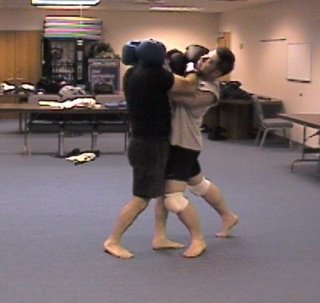 The fighter on your right is trying to lock up his opponent with a Thai clinch so he can begin applying the knee.
The fighter on your right is trying to lock up his opponent with a Thai clinch so he can begin applying the knee.Counter: A forearm or palm to the face (forearm preferred) works almost every time. Just put it in the face and drive! The full-contact legend, Joe Lewis (http://www.joelewisfightingsystems.com/) mentioned that at the Radford University Karate College in '94 or so. He's right, I can't hold on!
Defend University - nice site
Defend University is a research and development group dedicated to the exploration of leading edge techniques and strategies for self-defense, security and defensive tactics. Look here for info that can be applied to your personal protection, defensive tactics, executive protection, and martial arts programs.
Saturday, January 28, 2006
How to counter a blitz or rear-hand jab: Irimi!
[Click pictures to display full-size]
 1. The fighters face off. Their steely-eyed gazes look for non-existent openings.
1. The fighters face off. Their steely-eyed gazes look for non-existent openings.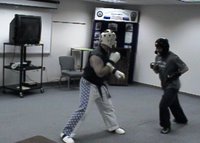 2. The lead-off fighter makes his move. The counter-fighter is still thinking about what he wants for breakfast after training.
2. The lead-off fighter makes his move. The counter-fighter is still thinking about what he wants for breakfast after training.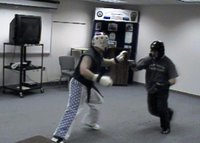 3. The lead-off fighter commits to his attack, a blitzing straight punch to the hungry fighter in the starry white pants, who recognizes the threat, and shifts left, then starts to redirect the attack with his lead guard hand. Notice the right is already getting ready to...
3. The lead-off fighter commits to his attack, a blitzing straight punch to the hungry fighter in the starry white pants, who recognizes the threat, and shifts left, then starts to redirect the attack with his lead guard hand. Notice the right is already getting ready to...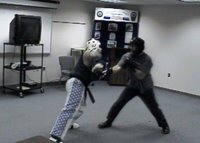 4. The counter fighter decides on settling on the attacker for breakfast, and commits his weight to his left (front) leg, and brings his forearm across. Notice that the lead-fighter is out of position to defend now, and his lead has been checked.
4. The counter fighter decides on settling on the attacker for breakfast, and commits his weight to his left (front) leg, and brings his forearm across. Notice that the lead-fighter is out of position to defend now, and his lead has been checked.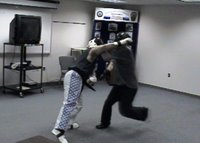 5. The conclusion of the technique. You can use a ridgehand, and can target the chest with control for less damage, or the nose/head for more. This can be a deadly counter, so USE CONTROL!
5. The conclusion of the technique. You can use a ridgehand, and can target the chest with control for less damage, or the nose/head for more. This can be a deadly counter, so USE CONTROL!
What You Need to Know to Protect Your Children
My wife and I have been accused of being "paraniod" about the safety of my children, and there may be some truth to that. I work at a police department, and unfortunately, have to hear about some of the things that happen to kids every day, and I am determined that none of them ever happen to my children, and pray that they never happen to yours. But, we need all the help we can get.
Please click the link/title to read the entire Black Belt Magazine article. Meanwhile, here are some key tips from the article that may help:
Practical Precautions
• Avoid writing your child’s name on clothes, lunch boxes or backpacks because it might enable a stranger to identify him.
• Tell your child that no one has the right to touch his body.
• Teach your child not to speak to strangers or accept gifts from them. If someone approaches your child on the street, he should stand at least five feet away from the stranger at all times, thus creating a gap that will allow the youngster to get away if he feels threatened.
• Accompany your child to public restrooms. If you cannot go in together, stand at the door and monitor how long the kid is inside.
• Have your child fingerprinted.
• Encourage your child to confide in you. Keeping secrets can result in increasingly
dangerous situations.
• Support your child if he refuses to hug and kiss relatives, for that attitude will make it easier for him to say “No!” to a touchy-feely stranger.
• Enroll your child in a reality-based self-defense program to increase his awareness and learn practical martial arts techniques.Who Is After Your Children?
Wing chun kung fu expert and Black Belt Hall of Fame member William Cheung, a resident of Melbourne, Australia, created the Stranger Danger program to teach people about 10 common ploys abductors use to lure children:
• Giving gifts: The stranger offers the child candy or a toy.
• Being friendly: The stranger tries to get close by being nice.
• Playing games: The stranger invents a game to get the child’s attention.
• Acting helpless: The stranger pretends to need assistance.
• Being the leader: The stranger says, “Follow me so we can play a game.”
• Posing as a magician: The stranger does magic tricks to attract the kid.
• Playing the messenger: The stranger tells the child his mother or father sent him to deliver a message.
• Making promises: The stranger promises to take the child someplace fun—such as an amusement park.
• Being “Mr. Cool”: The stranger tries to impress the child.
• Acting scary: The stranger threatens the child.
An Ex-Cop Teaches 4 Self-Defense Techniques That Really Work!
The following are four techniques from his Koga jutsu system. As you study them, rest assured they are among the most effective in the world.
REAR CHOKE DEFENSE
If an assailant rushes up behind you and wraps his fingers around your neck, you may not be able to simply reach up and peel his hands off, Koga says. To more efficiently defend against such an attack, you should widen your stance to lower your body, tilt your torso to the right to improve the angle at which you must function, and grab his right hand with your right hand. Next, step backward with your right foot and kneel as you pry his right hand away from your neck. A quick two-hand wrist twist will then flip him onto his back.“If you twist and pull, there’s a chance you can injure his wrist,” Koga says, “but the
body tends to follow [the force] and turn completely over.”The goal of this defensive technique is to get the assailant off your back as quickly as possible and toss him to the ground, Koga says. After that, he will be sufficiently
incapacitated for you to escape or execute a follow-up technique to render him unconscious.Escalation: Although this aikido throw is not lethal, the shock of being hurled forcibly onto the ground can knock out a person who is not accustomed to breakfalls, Koga says. And if you crank his wrist hard enough, it is possible to break the bones, he adds.
Mistakes: If you fail to tilt your upper body, you may not develop enough leverage to throw the assailant, and if you don’t step backward far enough, you could end up in a wrestling match, Koga warns. “If the mistake you make is bad enough and the guy knows what he’s doing, a multitude of things could happen depending on what he knows and what your athletic abilities are.”
PUNCH DEFENSE NO. 1
If a thug threatens to take your head off with a punch, you should immediately immediately step toward him, slipping inside and under his arm, Koga says. Your left foot is positioned between his feet, and your right hand protects the left side of your face. From there, you can strike his unprotected groin with your left hand.The pain of such a blow will cause him to stop, and when he does, you should grab the back of his neck with both hands and pull his head downward as you twist clockwise, flipping him onto the ground at your feet.
Next, squat down to drive your right knee into his collarbone. “It will also push his face sideways and pin him,” Koga says. Then catch his right arm with your hands while maintaining the pressure with your knee. Finish with an armbar; you need not fall to your back for it to be effective.
Escalation: If you throw the attacker with sufficient force, you can stun or disorient him, Koga says. If you drive your knee downward with excessive zeal, you can break his collarbone— which will terminate the fight instantly.
Mistakes: If you are not fast enough to avoid his punch, you will be hit, Koga says. And if you are struck while you’re moving toward the attacker, the blow can be especially damaging.
PUNCH DEFENSE NO. 2
If a hoodlum approaches you and throws a right cross at your face, you can use your left hand to deflect the punch to your right as you slip to the outside, Koga says. Before he can retract his arm for another attack, raise your right hand and use it to collapse his punching arm so your left arm can pin it against your chest. Because that
action pulls him forward, it disrupts his balance.Next, strike his face or eyes with your open right hand, but be sure to keep his right hand trapped against your body. Then use your right forearm to apply pressure against the crook of his right arm while you rotate your body counterclockwise, forcing him to the floor.
As soon as he lands on his back, lift his right arm to roll him onto his stomach, where it is easier to maintain control. Quickly maneuver to the right side of his body and immobilize him with an armbar and/or wrist lock.
Escalation: The opening techniques of this sequence will not seriously injure the assailant, but when done with sufficient force, the final joint lock can break bones.
Mistakes: If you do not deflect the opponent’s punching hand quickly enough, you can be struck and possibly knocked out, Koga says.
GUN DEFENSE
A classic hostage scenario features an assailant wrapping his left arm around your
neck while he holds a gun to your right ear, Koga says. The defensive response he recommends begins with your left hand reaching across the front of your body and making contact with the weapon. If the assailant is standing behind you and off to your right, he says, chances are his field of vision will not encompass the left side of your body. “By the time he sees your left hand move, it’s already hit his hand and the gun has hit him in the face,” he says.The blow distracts the attacker and gives you a window of opportunity to grab the weapon and weapon hand. Immediately take control of it and keep it pointed away from yourself. To effect the disarm, twist his wrist to the outside, grab the barrel with your right hand and continue to twist. As you crank his arm in front of your body, he is thrown to the ground. Maintain control of his weapon hand with your left hand as you leverage the gun from his grasp with your right hand. Finally, press the gun against his elbow, roll him onto his stomach and immobilize his limb with an armbar and wrist lock.
Escalation: “You can take him down gently, or you can really crank his arm and damage his wrist and elbow,” Koga says. “And, of course, if you slam him to the ground, that will cause him even more pain.”
Mistakes: If you use your right hand to strike the assailant in the groin, you might get yourself killed because his finger is probably on the trigger, and the pain of your blow will cause him to contract the muscles in his hands and fire the weapon. Therefore, your very first move, should you decide not to comply with his demands, must be to direct the muzzle of the gun away from your body.
Friday, January 27, 2006
Training Log 1-21-2006
Participants: Nathan, Sam, Mike, Bobby
Due to the rude behavior of Lt. Tim (just kidding!), we had to end way short of when we wanted, and finished at about 8:40 AM.
Today was Bobby’s first training. Darren was working, and unable to attend.
Objectives:
Training objectives:
- Learn the warm-up
- Review/learn the basics of boxing, front kick, knees, and Thai kicks
- Drills on sucker punch
- Arm-bars
- Finger-locks
Training Summary:
- Sam led a warm-up beginning at about 0745
- Sam then led us in shadow-boxing. Bobby knows front-hand palm strike, knifehand/open-hand strike, elbows, knees
- Drilled basicsFinger-jab – remember, with a lead, weapon, then feet. Fire the weapon, push off the rear foot, then drag it back into the on-guard stance again
Remember to keep the guard hand in front during the lead – Mike, work on this. Sam, yours looked good
Step-back, then jab – Remember to do it in that order
Single jab
Double jab
Triple jab
1-2
1-1-2
Lead hook (punch 3), then lead body hook
Double lead hook (low, then high)1-2 (low, then high)
Lead-off palm to the nose
Lead open hand to the side of the head, then rear hand
Rear uppercut (punch 4) to the head, then to the body
Lead uppercut (punch 5) to the head, then to the body
Overhand – remember you can do this with a fist, a ridgehand (not recommended), a knifehand, or an openhand
Front kicks
Knees – front, roundhouse, then outside (Mike wondered about the effectiveness. I will show him next week. - Sparring (all w/ MMA gloves, meaning grabs and open-hand strikes are permitted
R1 Sam vs Mike- Beginning of the round was all at kicking and long punching (1-2-6) range, then was in punching range. Both were effectively using the finger-jab and the rear hand open-hand strike. They didn’t get in close at all to use anything else. Very good use of circular movement. Sam scored about three times with wide rear hands, and Mike once, I believe. At the end, Sam did a nice catch with a rear-hand counter over top.
R2 Nathan vs Sam- Hands only. We had a much faster pace, more aggressive affair with me chasing and Sam working on countering (the reverse of our typical encounters). My usual lead-off/closing the gap technique was to check the lead hand, or fake a high lead to freeze my opponent. Sam said he threw an elbow to the body that scored (off-camera), and I probably landed a few to the head – they were very effective as an infighting weapon. Control was pretty good to the head, only touches; I think the goggles are working out well. Very fast pace.
R3 Mike vs Nathan- just hands again. Mike was pretty aggressive, though throwing most everything wide. I was countering more than against Sam, and tried to take a break, but Mike wouldn’t let me. He throw three wide open hand strikes high, then three low straight punches to the body, then cleared – nice. Overall decent round for Mike. Not real effective leading off, but once in range does a good job. Throw more straight techniques on the way in to close the gap safely! Slow jab was still used, though.
R4 Sam vs Mike, kicks to body allowed. Sam was the first one to start using the backfist, and did it well. He threw a backfist to lead off, connected. Threw it again, and connected, then a backfist, skip-roundhouse, and connected with both. Sweet! Mike, where was the guard??!! Sam locked up and used the knee very well. He’s getting good at that. Overall, not a good kicking round for either player, but Mike is getting more comfortable with it.
R5 Nathan vs Sam- This was a rumble!!! It was a blast, though. We went at it like it was a streetfight (just more acrobatic, skilled, Chan and Bruce Lee-like!)! I went after him hard, and it was like running into a buzzsaw. Sam promptly ripped off my helmet and eye protection, then I did the same later in the round. I spent a lot of time locking him up and kneeing him, threw a Thai kick to the body (blocked), but am getting comfortable working in and out of the ranges and using all the appropriate techniques in said range. I escaped a Thai hold by lifting up his arm and levering it off, rather than ducking out. He then pushed me out of range rather than allowing me to lock him up in turn. I threw a lot of elbows (very effective), and like it!
Bobby:
- Work on Stance – sometimes lined up too narrow, with the front foot and back on a straight line. This also prevents you from being able to move laterally. This is suicidal!!
- Have one of us show you the proper guard position. Your DT guard position is defensive, and not universal; problem is that the position doesn’t allow you to fire an effective lead-off technique, only defend. Remember the axiom that the best defense is a good offense? This is true, many times.
- Work on lead-off techniques to get in. You are too open.
- No more slow lead. I love when you do it, cause I can always connect by countering with a right over the top. Watch the tape!
- Still need to work on defending the knee.
- Work on integrating the techniques and using them at the appropriate range – it’ll take time.
- Hit the shield to get the range on kicking.
Sam:
- Fire through the target with the rear-hand – remember the power of a cross or straight comes from turning the hip, turn the rear shoulder in, then then weapon (cross, straight, overhand, knifehand, etc.). Remember the power comes from the legs and trunk. The only thing the arms do is provide snap and extension. Recommendation: drill making sure the rear heel is turned out completely when the move is finished. Do it slo-mo for a few dozen reps.
- Drill defensive kicking as a counter/stop-hit.
Nathan:
- I have a lazy lead hand, which allows opponents in without paying a price. Keep the lead aimed! - Circle! Practice what you preach there
- Inconsistent clearing
- Not staying covered in close! Why? Get that guard up!
- Uppercuts to the head are such a good punch – use it.
- Backfist, both horizontal and vertical are great leads and counters
- Topfist works
- PCJ: Don’t look down! Weight distribution on the back stance is off. Make sure to fully chamber before the low double-knifehands. Is the reverse punch with a kiap (2nd kiap) a medium or high punch? Reach out more for the elbow smash. Timing was right.
- Mix in overhands more, and don’t let someone clinch if you don’t want to rest.
- Clear! Get behind the opponent and counter, then clear.
- Use the shifty footwork.
- Simultaneous slip & counter.
- Don’t get hit so much, use your footwork!!!
Bring your footgear, goggle, groin cups, and other pads!
- Mr. Sam warmup
- Demonstrate arm bars, wrist locks, finger locks
- Mike: Integrating front and roundhouse into offense
- Bobby: basics. Mostly stance, guard, and movement
- Teach the elbows – drills and targets
- Sucker punch defenses with follow-up
- Thai kick and defenses to the legs
- Spar with knees, front kick. Nathan and Sam with all techniques
- Wrestling for knee position
- Burnouts with knees and body kicking. We will be wearing goggles, MMA gloves, and footgear for entire training
Observations:
- When drilling, intent! Commit, or you're wasting time
- Always check ABOVE the elbow or else the hand is still free
- If someone tries to check you below the below, hit ‘em!
- Sam asked about increasing hand speedA. Practice fast and,B. Increase apparent hand speed by:Keeping hands in motion to decrease inertiaFiring in a straight line, level with the eyesWeapons before footwork – no telegraphing always!
How to Win a Fight: Self-Defense Strategies for the Untrained Fighter
First of all, wake up! Remember, it’s always easier to STAY out of trouble than to GET out of trouble.
Second of all, keep from getting hit in a vital area!
*Get your hands up in front of your face to protect your head.
*Keep your mouth closed with your teeth clenched. When your mouth is open you are ripe to get your jaw broken (which means you should forget about ‘talking trash’).
*Circle away from his power side (circle to the right if he has his right hand cocked back, circle to the left if he has his left hand cocked back).
*You need to be either two arms lengths away from him (outside of his kicking range) or all the way in tight against him (holding him in a boxing clinch). Anything in between puts you in range for his punches and kicks.
Third, use your strongest weapons against his weakest targets.
*Use the proverbial knee to the groin when you are clinching.
*Smash him with your elbows in the face, throat and neck.
*Kick him in the knee, groin or lower abdomen. Kick straight ahead using the bottom of your foot like you would kick in a door. Or kick straight back like a mule using your heel. If you are untrained, resist the urge to kick with the top of your foot like you are punting a football, you will probably use too much of your toes instead of your shin (ouch!).
*If you try to trade punches with him, you're probably playing right into his game.
Finally:
*Get a barrier between you and him (even if you have to run around a car).
*Yell for help. You can't count on people coming to your aid, but he might think someone will render assistance.
*Use a weapon. Hose him down with your pepper spray. Use a chair like a lion tamer. Throw ashtrays at him.
*Make your escape. Lose your ego and your attitude. Retreat and escape. Live to go out and party again next weekend.
*Better yet, start training tomorrow in a self-defense art or program.
____
All rights reserved. Permission must be obtained before use. Copyright 2006
KNEE THRUST
In this article, the Vietnamese-born champ will introduce you to three ways to dynamically defend against a relatively new element that has been tossed into the san shou technical mix: the knee strike.
5 WAYS OF ATTACK - JKD
Close to Roundhouse Knee
 1. Instead of closing the gap with a jab, the lead-off fighter uses a check of the right hand of the counter-fighter.
1. Instead of closing the gap with a jab, the lead-off fighter uses a check of the right hand of the counter-fighter. 2. Inside the guard, and on the flank, the right hand latches behind the neck.
2. Inside the guard, and on the flank, the right hand latches behind the neck. 3. The knee to the face is delivered.
3. The knee to the face is delivered.The important thing to remember is that as long as you close the gap properly, any technique can be used - even a "counter". Why wait for your opponent to lead-he might hit you!
Maxim: "It's always faster to act than to react."
Thursday, January 26, 2006
Speed Punching
The payoff:
Specific Tips on the heavy bag:First the science. At one time or another, you’ve probably had someone explain the physics of hitting hard. In short, increasing your speed is more important than increasing the mass of your fist. Technically, it’s stated by a simple equation:
ke=1/2mv2
In English, kinetic energy equals one half mass times velocity squared. In simpler terms, the energy of your moving fist and arm increases if the weight of your fist increases, but it jumps even more if your fist moves more quickly.
Therefore, if you increase the mass of your hand by 10 percent, you get a straight 10-percent increase in kinetic energy. However, if you increase your hand speed by the same amount, you get a 21-percent increase in kinetic energy. Obviously, hitting with greater speed pays off with slightly more than twice the kinetic energy.
- Relax. Don’t tense up when you punch. Don’t strain. As boxers say, "Don’t flex, punch." Just relax and let your fists fly.
"Speed is a relaxed muscle contracting very quickly," says Black Belt Hall of Fame member Bill Wallace. "The problem is that most people anticipate the action they’re about to perform and tense the muscles they’re going to use. What happens then is they’re trying to move an already contracted muscle. They now have the antagonistic and agonistic muscles working against each other, and this hurts their speed." You can avoid that by staying relaxed. - Don’t give away your speed advantage by telegraphing. One of the easiest ways to teach yourself not to telegraph is to be sure you’re moving your striking body part before you move anything else. If you want to throw a punch, your hand must move first. (Note that doing this will also force you to relax.)
- Bring it back fast. Don’t just speed up your outbound movement; accelerate the retrieval as well.
In combinations:
- A great way to accelerate your punches involves overlapping the movements of a combination you happen to favor. If you’re familiar with the computer concept of "pipelining," you know that overlapping can speed up a set of actions that are supposed to be executed sequentially.
In sparring:
- If you fire your punch from an obscured position, you’ve increased the "perceived" speed of your technique.
- One proven method involves edging toward your opponent, then leaning back slightly so you’re actually closer than you appear before you drop your lead hand. From that position, you can execute a straight lead-arm strike to the jaw as you lean forward. The combination of suddenly leaning forward—and in so doing, showing your opponent how close you actually are since the placement of your feet means most of the gap has been closed in advance—while delivering a strike that comes from below his field of vision and most likely from a position that’s at least partially hidden by his guard will enable you to hit him before he knows what’s happening.
And these interesting ideas:
- Blitzing while you jog is a great way to increase your speed. When you’re out for your morning run, break your gait by suddenly performing blitzing footwork—in other words, shooting your lead foot back as you cross-step with your rear foot and "fall" forward.
- Another drill for speed hitting is the partner coin drop. Have a classmate release a coin while you try to catch it in midair, put it on his open palm and quickly snatch it away. It works because it develops your hand speed while forcing you to react as soon as your partner acts.
- A quick way to increase your explosiveness, which is a very practical form of speed for martial artists, is to do push-ups starting from the down position. Thrust your arms out as quickly as you can. Aim to propel your body so high that your hands leave the floor. Fringe benefit: You’ll add strength to your arm muscles, too.
And this final tip:
Smooth Is Fast
Philadelphia’s Steve Maxwell, a four-time world jujutsu champion, offers a scientific explanation of the way the human body builds speed in techniques: "Smooth is fast. It takes considerable repetition of a skill movement at slower speeds until the technique is embodied in the nervous system. Once that happens, the application becomes faster and faster.
"I teach my students speed by first teaching them to execute the movement slowly. It’s only after many repetitions that full-speed execution is practiced. Later, timing and precision are added, which make the techniques even faster. Speed is built through execution of takedowns, throws, sweeps and finishing holds exactly as [they] would be applied in combat or competition. Speed is specific to the skill to which it is applied."
Wednesday, January 25, 2006
How to Create an Opening: 101
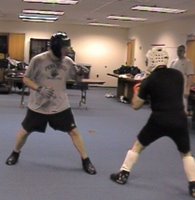 1. Mr. Sam sees an opening, and takes it...
1. Mr. Sam sees an opening, and takes it... 2. The lead-off fighter fires a quick backfist to the temple, landing.
2. The lead-off fighter fires a quick backfist to the temple, landing.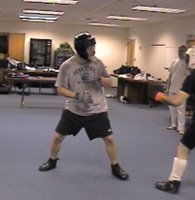 3. The opening is still there!
3. The opening is still there! 4. He fires it again, scoring, but now brings the guard of the counter-fighter up.
4. He fires it again, scoring, but now brings the guard of the counter-fighter up.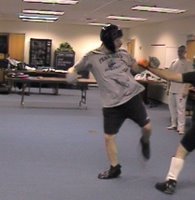
5. Creating an opening...
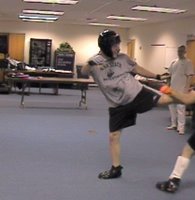
6. For the roundhouse kick. Three scores in one combination - nice.
Passing it along
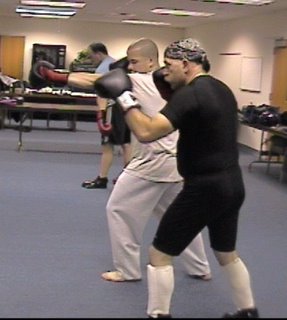
I wasn't able to observe first-hand, when I was watching the tape, it looks like Mike did a great job passing along valuable tools to Bobby.
Bobby's defensive tactics and prior experience with us in Martial Arts for Public Safety should help a lot. Welcome Bobby, and kudos to Mike F!
WOMAN VS. MAN
Lesseos started judo at age 6 and went on to Greco-Roman and pro wrestling. She competed as a professional fighter for 12 years. “My first professional match was at 16,” she says. “Then I got into kickboxing, and I’ve done some taekwondo because the last seven years of my professional fighting were in full-contact shootfighting in Japan, Peru and Europe. That was the hardest martial arts [training] I have gone through. It was full-contact, anything goes.”Lesseos, who was known as “Magnificent Mimi” on the pro wrestling circuit, has also trained with grappling legend Gene LeBell for the past 15 years, and with sambo and fullcontact karate expert Gokor Chivichyan for nearly as long.
Mike knows a Marine reservist
Sounds great!
Proper form on a 1-2 combination
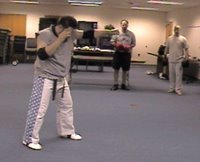 1. Fire a lead-hand technique (jab, palm strike, back/hammer fist). Step forward simultaneously with the lead foot, and step a little to the side of the opponent.
1. Fire a lead-hand technique (jab, palm strike, back/hammer fist). Step forward simultaneously with the lead foot, and step a little to the side of the opponent.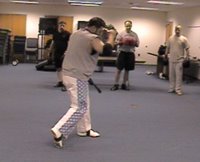 2. While covering up with the lead hand, turn the rear hips toward the target, turn over the rear heel, then, while shifting the weight forward on to your lead foot, torque the rear shoulder toward the front, then...
2. While covering up with the lead hand, turn the rear hips toward the target, turn over the rear heel, then, while shifting the weight forward on to your lead foot, torque the rear shoulder toward the front, then...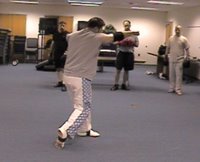 3. Fire the rear hand (straight, cross, palm, overhand, etc.) throught the target. Snap the hand back into a guard position, and try to finish with a lead-hand technique or clear immediately - you are vulnerable to a counter. Notice the rear shoulder is up, and the elbow stays high to prevent a counter-hook punch over the right. Also, notice the body position, and that I am firing with the shoulder level with the target. If you want to throw this to the body, get low; don't punch down.
3. Fire the rear hand (straight, cross, palm, overhand, etc.) throught the target. Snap the hand back into a guard position, and try to finish with a lead-hand technique or clear immediately - you are vulnerable to a counter. Notice the rear shoulder is up, and the elbow stays high to prevent a counter-hook punch over the right. Also, notice the body position, and that I am firing with the shoulder level with the target. If you want to throw this to the body, get low; don't punch down.Comments?
STREET SMARTS
Since retiring from law enforcement, he’s concentrated on spreading all that hard-earned knowledge to those members of the public interested in learning
state-of-the-art self defense, including knife, gun, stick and empty-hand skills.
His philosophy is all practical:
Practice hitting hard. Even though it sounds way too fundamental to ever be neglected, more than a few martial artists overlook it, he claims. Instead of power, they focus on precision, speed and even the innocent ability to stop their foot or fist a fraction of an inch from their target. None of those attributes will save your hide in a dark alley. Unloading a full-power kick, punch, elbow or knee will. "The same can be said of swinging a knife or stick," he says. "Always try to hit training objects hard and envision hitting a body part while doing it."I agree with this. That's why I emphasize hitting the shields and pads (bags at home) in between controlled, light to medium contact. Practice hitting lightly and that's how you'll react.
Don’t neglect unconventional strikes. Martial arts instructors earn their living by telling students that precision kicks and punches are the way to go, and that’s fine, Hochheim says. "But you should also think about using other techniques such as the forearm strike and the body ram. They can be unexpected and effective. Just beware of the head butt, for you can stun yourself or even knock yourself out in the middle of a fight. God did not make the human head to be an impact weapon."
When all else fails, throw a palm to the chin. An upward-bound open-hand blast to the chin can be a knockout blow that shoots in from an unexpected angle below the line of sight. And if your fingers are long enough, he says, they will snap forward
on impact and hit him in the eyes.Venture outside your safe zone. Good kickers tend to make every sparring session a kicking-only match, and good punchers tend to make every self-defense drill revolve around hand techniques. "To prepare yourself for any eventuality, however, you must familiarize yourself with all ranges of combat—standing, kneeling, seated and on the ground with and without weapons—and become proficient at them," he says.
This is very true. I find myself going back to what I'm comfortable with - boxing and knees, then kicking, in that order. I need to challenge myself to grapple more.
Train for skilled and unskilled assailants. Of course you’ll want to develop the skills you’d need to combat the most dangerous adversary you can imagine, but you also have to think about how you’d handle a sloppy drunk at a party and a recalcitrant teen-ager caught trying to vandalize your mailbox. "Most of the criminal world is untrained," he says. "Martial artists routinely train to defeat the jab, for example, yet 99.9 percent of the population does not know how to throw any type of sporting punch. Focus on preparing yourself to deal with sucker punches and haymakers before you problem-solve sporting punches."
Follow the skill-development progression. Whether you’re honing your weapons skills or empty-hand techniques, you should methodically work your way up the ladder of mastery. "First, learn the new tactic," Hochheim says. "Second,
perfect the skills you need to do it using partner drills. Third, trouble-shoot it for the typical problems. Fourth, work on counters to add depth to your troubleshooting. Finally, practice it in combat scenarios." It’s a tried-and true method for committing new techniques to memory, and it’s the best way to make them available to you during the heat of battle.
It's good. Read it all. Also, check the link to his site and blog on our Links.
Friday, January 20, 2006
Training agenda for Saturday 1/21
- Learn the warm-up
- Review/learn the basics of boxing, front kick, knees, and Thai kicks
- Drills on sucker punch
- Arm-bars
- Finger-locks
Saturday, January 14, 2006
Numerous thoughts on our training
- Mike- Work on a lot of shield and bag work with the front kick. Not confident with the range, so you need to be hitting something. Time the shield coming at you, and hit the bag just for range.
- All of us need to constantly emphasize circular footwork when not engaged. Don't just stand there, and don't got straight back. It's OK to close straight in, but never clear or retreat straight back. Clear at an angle. Constantly circle. If you're not leading off, you should be circling to disrupt the rhythm of the opponent-don't let him get set.
- Mr. Sam- recommendations: fire through the target. Practice hitting a target glove and x-ray paper to get used to fire through a target. Also, much drilling in the air will help.
- Drill a ton of techniques with control on a live person, and, every training session, hit the pads or shields so that we don't get used to controlling a technique and corrupt our reflexes and muscle memory. As far as hand techniques, use the palm strike (aim for the forehead in training), use open-hand strike and knife-hand to the side of the head and back of the head, ridge-hand, topfist punch, and hammerfist. Also, hook to the side of the neck.
- Start to work in the following:
Leg kicking
Checks and releasing from the check
Trapping
Grabbing and striking
Lever block and vertical hammerfist - We need to work on one self-defense technique per training
- Teach the back hammerfist as a good lead-off technique
- Teach the techniques to the body: hook, open-hand, palm strike, forearm, elbow
- Constantly drill hand speed
- Sam and I need to start using Thai, roundhouse, side, and back kicks now.
- Drill the lift, snap, and roundhouse kicks to the groin as a target. Practice defending the knee to the groin.
- Drill transition from the roundhouse knee counter to locking up. Also, on the knee, don't hold back. Throw and contact with it to all targets except the face.
- I need to start grabbing more - use it for creating openings, and to disrupt the opponent's offense.
- We need to use good control, but make sure to throw everything with out reaching.
Wednesday, January 11, 2006
Counter to a block and trap of the kicking leg
1.
 Mike blocks the front kick, then sweeps it upward with his hand to keep me off balance.
Mike blocks the front kick, then sweeps it upward with his hand to keep me off balance.2.
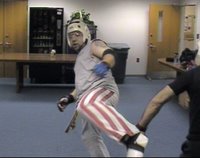 Instead of letting him knock my leg down, or turn me, I use the momentum of the block (which was done very well, BTW) to turn me.
Instead of letting him knock my leg down, or turn me, I use the momentum of the block (which was done very well, BTW) to turn me.3.
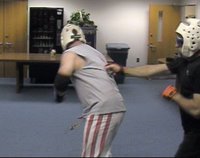 I plant the left leg, which was blocked. Mike has stepped forward with his left and throws a counter right hand.
I plant the left leg, which was blocked. Mike has stepped forward with his left and throws a counter right hand.4.
 I chamber, and fire the turning back kick under his outstretched arm into the extended ribs.
I chamber, and fire the turning back kick under his outstretched arm into the extended ribs.5.
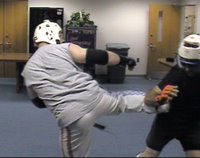 Using excellent control, I push instead of blasting, but you can see the potential pain! I love it!
Using excellent control, I push instead of blasting, but you can see the potential pain! I love it!
Check, step-around, and counter
1.
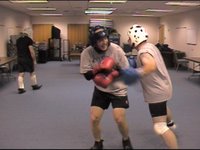 1. Here is the step-around. Notice the check with my right hand. If I check above the elbow, I can turn the opponent, or step-around safely, and get away from this hands. I can also push to stop anything he can do with his feet or knees.
1. Here is the step-around. Notice the check with my right hand. If I check above the elbow, I can turn the opponent, or step-around safely, and get away from this hands. I can also push to stop anything he can do with his feet or knees.2.
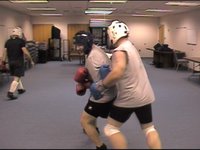 2. To prevent me from firing a counter, Sam bumps back into me to disrupt my counter.
2. To prevent me from firing a counter, Sam bumps back into me to disrupt my counter.3.
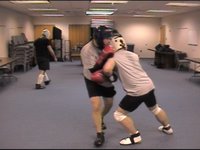 3. Sam tries to turn around, escaping the check, and wants to counter. By bumping him with the shoulder, it traps his hands and gets him back on his heels. If you can't transfer your weight into something, you can't hurt it. Sam is now back on his heels, and I'm set.
3. Sam tries to turn around, escaping the check, and wants to counter. By bumping him with the shoulder, it traps his hands and gets him back on his heels. If you can't transfer your weight into something, you can't hurt it. Sam is now back on his heels, and I'm set.4.
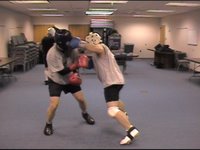 4. A short, straight left counter. You notice I am clearing around to the right again? Here we go!
4. A short, straight left counter. You notice I am clearing around to the right again? Here we go!
Straight right counter-Shoulder roll to Knee

2.
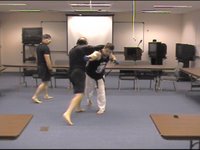
3.
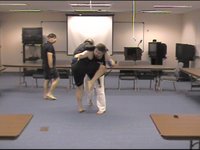
This is a nice counter - it neutralizes the straight, and they lead-off fighter's momentum takes him into the technique.
1. Roll the right hand. Remember to keep the guard hand up.
2. "Latch" the neck. Even with boxing gloves on (MMA gloves in the example), you can do this.
3. Thrust the roundhouse knee into the face , thigh, or trunk.
After the counter - knee as many times as you can - transition into a slashing elbow strike to the head, or Thai clinch to dish out more punishment. Never just let go - think CLEAR safely!
Marines go to the mat -- The Washington Times
Although they lead the world's best-equipped fighting force, senior U.S. commanders have wanted to ensure that underneath the Kevlar and microchips beats the heart of a fighter who can prevail with little more than bare hands.
'I want the Marines who take this course and then return to duty feeling, 'Now people are safer because I'm here,' ' Col. Shusko says.
The motto 'One Mind, Any Weapon' is emblazoned on the T-shirt of every instructor at MCMAP, which teaches 184 fighting techniques and more than 60 character-building lessons.
Like traditional martial-arts disciplines, MCMAP uses a belt-ranking system: tan, gray, green, brown and black.
Every Marine is required to become a tan belt, and the highest rank is the sixth-degree black belt.
The Corps currently has more than 217,000 active and reserve Marines serving today, and there are 10,000 green-belt instructors, who are qualified to teach and test tan- and gray-belt students.
About 1,300 black-belt instructors are capable of testing students up to black belt.
Col. Shusko, MCMAP's director since 2003, believes his is the largest martial-arts school in the world, with more than 150,000 students across the range of tan through black belts. He personally has seen about 11,000 Marines go though MCMAP training. "



